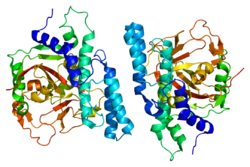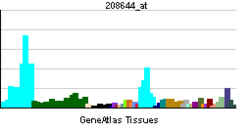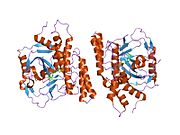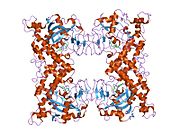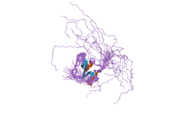- PARP1
-
Poly [ADP-ribose] polymerase 1 (PARP-1) also known as NAD+ ADP-ribosyltransferase 1 or poly[ADP-ribose] synthase 1 is an enzyme that in humans is encoded by the PARP1 gene.[1]
Contents
Function
PARP1 works:
- By modifying nuclear proteins by poly ADP-ribosylation.
- In conjunction with BRCA, which acts on double strands; members of the PARP family act on single strands; or, when BRCA fails, PARP takes over those jobs as well.
PARP1 is involved in:
- Differentiation, proliferation, and tumor transformation
- Normal or abnormal recovery from DNA damage
- May be the site of mutation in Fanconi anemia[citation needed]
- May participate in the pathophysiology of type I diabetes.[2]
PARP1 is activated by:
- Helicobacter pylori in the development and proliferation of gastric cancer.[3]
Role in DNA damage repair
PARP1 has a role in repair of single-stranded DNA (ssDNA) breaks. Knocking down intracellular PARP1 levels with siRNA or inhibiting PARP1 activity with small molecules reduces repair of ssDNA breaks. In the absence of PARP1, when these breaks are encountered during DNA replication, the replication fork stalls, and double-strand DNA (dsDNA) breaks accumulate. These dsDNA breaks are repaired via homologous recombination (HR) repair, a potentially error-free repair mechanism. For this reason, cells lacking PARP1 show a hyper-recombinagenic phenotype (e.g., an increased frequency of HR),[4][5][6] which has also been observed in vivo in mice using the pun assay.[7] Thus, if the HR pathway is functioning, PARP1 null mutants (cells without functioning PARP1) do not show an unhealthy phenotype, and in fact, PARP1 knockout mice show no negative phenotype and no increased incidence of tumor formation.[8]
Interaction with BRCA1 and BRCA2
However, both BRCA1 and BRCA2 are at least partially necessary for the HR pathway to function. Therefore, cells that are deficient in BRCA1 or BRCA2 have been shown to be highly sensitive to PARP1 inhibition or knock-down, resulting in cell death by apoptosis, in stark contrast to cells with at least one good copy of both BRCA1 and BRCA2. Many breast cancers have defects in the BRCA1/BRCA2 HR repair pathway due to mutations in either BRCA1 or BRCA2, or other essential genes in the pathway (the latter termed cancers with "BRCAness"). Tumors with BRCAness are hypothesized to be highly sensitive to PARP1 inhibitors, and it has been demonstrated in mice that these inhibitors can both prevent BRCA1/2-deficient xenografts from becoming tumors and eradicate tumors having previously formed from BRCA1/2-deficient xenografts.
Application to cancer therapy
It is hypothesized that PARP1 inhibitors may prove highly effective therapies for cancers with BRCAness, due to the high sensitivity of the tumors to the inhibitor and the lack of deleterious effects on the remaining healthy cells with functioning BRCA HR pathway. This is in contrast to conventional chemotherapies, which are highly toxic to all cells and can induce DNA damage in healthy cells, leading to secondary cancer generation.[9][10]
Interactions
PARP1 has been shown to interact with ZNF423,[11] Polymerase (DNA directed), alpha 1,[12] RELA,[13] XRCC1,[14][15] POLA2,[12] P53,[14][16] MYBL2[17] and Aprataxin.[14][18]
See also
- Poly ADP ribose polymerase
- PARP inhibitor class of investigational anti-cancer drugs
- olaparib a PARP inhibitor.
References
- ^ Ha HC, Snyder SH (Oct 2000). "Poly(ADP-ribose) polymerase-1 in the nervous system". Neurobiol Dis 7 (4): 225–39. doi:10.1006/nbdi.2000.0324. PMID 10964595.
- ^ "Entrez Gene: PARP1 poly (ADP-ribose) polymerase family, member 1". http://www.ncbi.nlm.nih.gov/sites/entrez?Db=gene&Cmd=ShowDetailView&TermToSearch=142.
- ^ http://www.physorg.com/news182001373.html Physorg:Team finds link between stomach-cancer bug and cancer-promoting factor
- ^ Godon C, Cordelières FP, Biard D, Giocanti N, Mégnin-Chanet F, Hall J, Favaudon V (August 2008). "PARP inhibition versus PARP-1 silencing: different outcomes in terms of single-strand break repair and radiation susceptibility". Nucleic Acids Res. 36 (13): 4454–64. doi:10.1093/nar/gkn403. PMC 2490739. PMID 18603595. http://www.pubmedcentral.nih.gov/articlerender.fcgi?tool=pmcentrez&artid=2490739.
- ^ Schultz N, Lopez E, Saleh-Gohari N, Helleday T (September 2003). "Poly(ADP-ribose) polymerase (PARP-1) has a controlling role in homologous recombination". Nucleic Acids Res. 31 (17): 4959–64. doi:10.1093/nar/gkg703. PMC 212803. PMID 12930944. http://www.pubmedcentral.nih.gov/articlerender.fcgi?tool=pmcentrez&artid=212803.
- ^ Waldman AS, Waldman BC (November 1991). "Stimulation of intrachromosomal homologous recombination in mammalian cells by an inhibitor of poly(ADP-ribosylation)". Nucleic Acids Res. 19 (21): 5943–7. doi:10.1093/nar/19.21.5943. PMC 329051. PMID 1945881. http://www.pubmedcentral.nih.gov/articlerender.fcgi?tool=pmcentrez&artid=329051.
- ^ Claybon A, Karia B, Bruce C, Bishop AJ (July 2010). "PARP1 suppresses homologous recombination events in mice in vivo". Nucleic Acids Res 38 (21): 7538–45. doi:10.1093/nar/gkq624. PMC 2995050. PMID 20660013. http://www.pubmedcentral.nih.gov/articlerender.fcgi?tool=pmcentrez&artid=2995050.
- ^ Wang ZQ, Auer B, Stingl L, Berghammer H, Haidacher D, Schweiger M, Wagner EF (March 1995). "Mice lacking ADPRT and poly(ADP-ribosyl)ation develop normally but are susceptible to skin disease". Genes Dev. 9 (5): 509–20. doi:10.1101/gad.9.5.509. PMID 7698643.
- ^ Bryant, Helen E.; Schultz, N.; Thomas, H. D.; Parker, K. M.; Flower, D.; Lopez, E.; Kyle, S.; Meuth, M.; Curtin, N.; Helleday, T. (2005). "Specific killing of BRCA2-deficient tumours with inhibitors of poly(ADP-ribose) polymerase". Nature 434 (7035): 913–917. doi:10.1038/nature03443. PMID 15829966.
- ^ Farmer, Hannah; McCabe, N.; Lord, C. J.; Tutt, A. N. J.; Johnson, D A.; Richardson, T. B.; Santarosa, M.; Dillon, K. J.; Hickson, I.; Knights, C.; Martin, M. M. B.; Jackson, S. P.; Smith, G. C. M.; Ashworth, A. (2005). "Targeting the DNA repair defect in BRCA mutant cells as a therapeutic strategy". Nature 434 (7035): 917–921. doi:10.1038/nature03445. PMID 15829967.
- ^ Ku MC, Stewart S, Hata A (November 2003). "Poly(ADP-ribose) polymerase 1 interacts with OAZ and regulates BMP-target genes". Biochem. Biophys. Res. Commun. 311 (3): 702–7. doi:10.1016/j.bbrc.2003.10.053. PMID 14623329.
- ^ a b Dantzer F, Nasheuer HP, Vonesch JL, de Murcia G, Ménissier-de Murcia J (April 1998). "Functional association of poly(ADP-ribose) polymerase with DNA polymerase alpha-primase complex: a link between DNA strand break detection and DNA replication". Nucleic Acids Res. 26 (8): 1891–8. doi:10.1093/nar/26.8.1891. PMC 147507. PMID 9518481. http://www.pubmedcentral.nih.gov/articlerender.fcgi?tool=pmcentrez&artid=147507.
- ^ Hassa PO, Covic M, Hasan S, Imhof R, Hottiger MO (December 2001). "The enzymatic and DNA binding activity of PARP-1 are not required for NF-kappa B coactivator function". J. Biol. Chem. 276 (49): 45588–97. doi:10.1074/jbc.M106528200. PMID 11590148.
- ^ a b c Gueven N, Becherel OJ, Kijas AW, Chen P, Howe O, Rudolph JH, Gatti R, Date H, Onodera O, Taucher-Scholz G, Lavin MF (May 2004). "Aprataxin, a novel protein that protects against genotoxic stress". Hum. Mol. Genet. 13 (10): 1081–93. doi:10.1093/hmg/ddh122. PMID 15044383.
- ^ Masson M, Niedergang C, Schreiber V, Muller S, Menissier-de Murcia J, de Murcia G (June 1998). "XRCC1 is specifically associated with poly(ADP-ribose) polymerase and negatively regulates its activity following DNA damage". Mol. Cell. Biol. 18 (6): 3563–71. PMC 108937. PMID 9584196. http://www.pubmedcentral.nih.gov/articlerender.fcgi?tool=pmcentrez&artid=108937.
- ^ Malanga M, Pleschke JM, Kleczkowska HE, Althaus FR (May 1998). "Poly(ADP-ribose) binds to specific domains of p53 and alters its DNA binding functions". J. Biol. Chem. 273 (19): 11839–43. doi:10.1074/jbc.273.19.11839. PMID 9565608.
- ^ Cervellera MN, Sala A (April 2000). "Poly(ADP-ribose) polymerase is a B-MYB coactivator". J. Biol. Chem. 275 (14): 10692–6. doi:10.1074/jbc.275.14.10692. PMID 10744766.
- ^ Morgan HE, Jefferson LS, Wolpert EB, Rannels DE (April 1971). "Regulation of protein synthesis in heart muscle. II. Effect of amino acid levels and insulin on ribosomal aggregation". J. Biol. Chem. 246 (7): 2163–70. PMID 5555565.
Further reading
- Helleday T, Bryant HE, Schultz N (2006). "Poly(ADP-ribose) polymerase (PARP-1) in homologous recombination and as a target for cancer therapy". Cell Cycle 4 (9): 1176–8. PMID 16123586.
- Baumgartner M, Schneider R, Auer B, et al. (1992). "Fluorescence in situ mapping of the human nuclear NAD+ ADP-ribosyltransferase gene (ADPRT) and two secondary sites to human chromosomal bands 1q42, 13q34, and 14q24". Cytogenet. Cell Genet. 61 (3): 172–4. doi:10.1159/000133400. PMID 1424803.
- Schreiber V, Molinete M, Boeuf H, et al. (1992). "The human poly(ADP-ribose) polymerase nuclear localization signal is a bipartite element functionally separate from DNA binding and catalytic activity". EMBO J. 11 (9): 3263–9. PMC 556860. PMID 1505517. http://www.pubmedcentral.nih.gov/articlerender.fcgi?tool=pmcentrez&artid=556860.
- Ogura T, Nyunoya H, Takahashi-Masutani M, et al. (1990). "Characterization of a putative promoter region of the human poly(ADP-ribose) polymerase gene: structural similarity to that of the DNA polymerase beta gene". Biochem. Biophys. Res. Commun. 167 (2): 701–10. doi:10.1016/0006-291X(90)92082-B. PMID 2108670.
- Gradwohl G, M?nissier de Murcia JM, Molinete M, et al. (1990). "The second zinc-finger domain of poly(ADP-ribose) polymerase determines specificity for single-stranded breaks in DNA". Proc. Natl. Acad. Sci. U.S.A. 87 (8): 2990–4. doi:10.1073/pnas.87.8.2990. PMC 53819. PMID 2109322. http://www.pubmedcentral.nih.gov/articlerender.fcgi?tool=pmcentrez&artid=53819.
- Simonin F, M?nissier-de Murcia J, Poch O, et al. (1990). "Expression and site-directed mutagenesis of the catalytic domain of human poly(ADP-ribose)polymerase in Escherichia coli. Lysine 893 is critical for activity". J. Biol. Chem. 265 (31): 19249–56. PMID 2121735.
- Ikejima M, Noguchi S, Yamashita R, et al. (1991). "The zinc fingers of human poly(ADP-ribose) polymerase are differentially required for the recognition of DNA breaks and nicks and the consequent enzyme activation. Other structures recognize intact DNA". J. Biol. Chem. 265 (35): 21907–13. PMID 2123876.
- Yokoyama Y, Kawamoto T, Mitsuuchi Y, et al. (1991). "Human poly(ADP-ribose) polymerase gene. Cloning of the promoter region". Eur. J. Biochem. 194 (2): 521–6. doi:10.1111/j.1432-1033.1990.tb15647.x. PMID 2125269.
- Ushiro H, Yokoyama Y, Shizuta Y (1987). "Purification and characterization of poly (ADP-ribose) synthetase from human placenta". J. Biol. Chem. 262 (5): 2352–7. PMID 2434482.
- Herzog H, Zabel BU, Schneider R, et al. (1989). "Human nuclear NAD+ ADP-ribosyltransferase: localization of the gene on chromosome 1q41-q42 and expression of an active human enzyme in Escherichia coli". Proc. Natl. Acad. Sci. U.S.A. 86 (10): 3514–8. doi:10.1073/pnas.86.10.3514. PMC 287168. PMID 2498872. http://www.pubmedcentral.nih.gov/articlerender.fcgi?tool=pmcentrez&artid=287168.
- Auer B, Nagl U, Herzog H, et al. (1990). "Human nuclear NAD+ ADP-ribosyltransferase(polymerizing): organization of the gene". DNA 8 (8): 575–80. doi:10.1089/dna.1989.8.575. PMID 2513174.
- Kurosaki T, Ushiro H, Mitsuuchi Y, et al. (1987). "Primary structure of human poly(ADP-ribose) synthetase as deduced from cDNA sequence". J. Biol. Chem. 262 (33): 15990–7. PMID 2824474.
- Cherney BW, McBride OW, Chen DF, et al. (1988). "cDNA sequence, protein structure, and chromosomal location of the human gene for poly(ADP-ribose) polymerase". Proc. Natl. Acad. Sci. U.S.A. 84 (23): 8370–4. doi:10.1073/pnas.84.23.8370. PMC 299544. PMID 2891139. http://www.pubmedcentral.nih.gov/articlerender.fcgi?tool=pmcentrez&artid=299544.
- Alkhatib HM, Chen DF, Cherney B, et al. (1987). "Cloning and expression of cDNA for human poly(ADP-ribose) polymerase". Proc. Natl. Acad. Sci. U.S.A. 84 (5): 1224–8. doi:10.1073/pnas.84.5.1224. PMC 304399. PMID 3029772. http://www.pubmedcentral.nih.gov/articlerender.fcgi?tool=pmcentrez&artid=304399.
- Loetscher P, Alvarez-Gonzalez R, Althaus FR (1987). "Poly(ADP-ribose) may signal changing metabolic conditions to the chromatin of mammalian cells". Proc. Natl. Acad. Sci. U.S.A. 84 (5): 1286–9. doi:10.1073/pnas.84.5.1286. PMC 304412. PMID 3103132. http://www.pubmedcentral.nih.gov/articlerender.fcgi?tool=pmcentrez&artid=304412.
- Suzuki H, Uchida K, Shima H, et al. (1987). "Molecular cloning of cDNA for human poly(ADP-ribose) polymerase and expression of its gene during HL-60 cell differentiation". Biochem. Biophys. Res. Commun. 146 (2): 403–9. doi:10.1016/0006-291X(87)90543-2. PMID 3113420.
- Uchida K, Morita T, Sato T, et al. (1987). "Nucleotide sequence of a full-length cDNA for human fibroblast poly(ADP-ribose) polymerase". Biochem. Biophys. Res. Commun. 148 (2): 617–22. doi:10.1016/0006-291X(87)90921-1. PMID 3120710.
- Schneider R, Auer B, K?hne C, et al. (1988). "Isolation of a cDNA clone for human NAD+: protein ADP-ribosyltransferase". Eur. J. Cell Biol. 44 (2): 302–7. PMID 3121332.
- Carter SG, Berger NA (1983). "Purification and characterization of human lymphoid poly(adenosine diphosphate ribose) polymerase". Biochemistry 21 (22): 5475–81. doi:10.1021/bi00265a015. PMID 6293541.
- Gu Y, Sarnecki C, Aldape RA, et al. (1995). "Cleavage of poly(ADP-ribose) polymerase by interleukin-1 beta converting enzyme and its homologs TX and Nedd-2". J. Biol. Chem. 270 (32): 18715–8. doi:10.1074/jbc.270.32.18715. PMID 7642516.
PDB gallery 1uk0: Crystal structure of catalytic domain of human poly(ADP-ribose) polymerase with a novel inhibitor1uk1: Crystal structure of human poly(ADP-ribose) polymerase complexed with a potent inhibitor1wok: Crystal structure of catalytic domain of human poly(ADP-ribose) polymerase complexed with a quinoxaline-type inhibitor2cok: Solution structure of BRCT domain of poly(ADP-ribose) polymerase-12cr9: Solution structure of WGR domain of poly(ADP-ribose) polymerase-12cs2: Solution structure of the second Zn-finger domain of poly(ADP-ribose) polymerase-12dmj: Solution structure of the first zf-PARP domain of human Poly(ADP-ribose)polymerase-1Categories:- Human proteins
Wikimedia Foundation. 2010.

